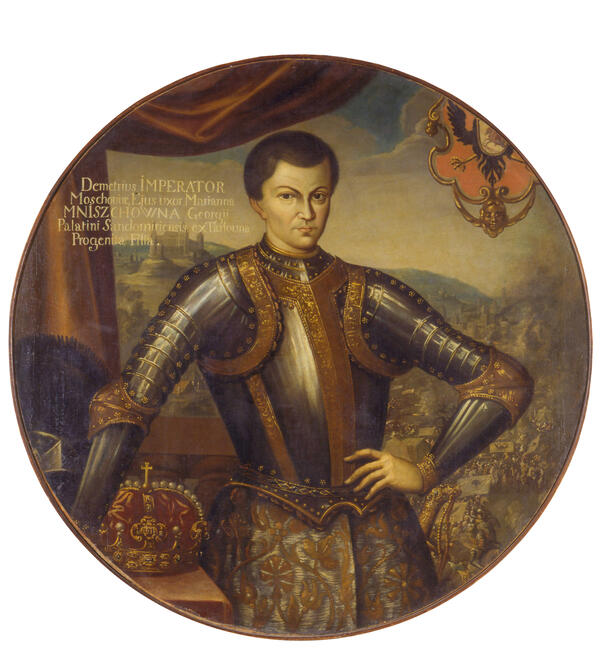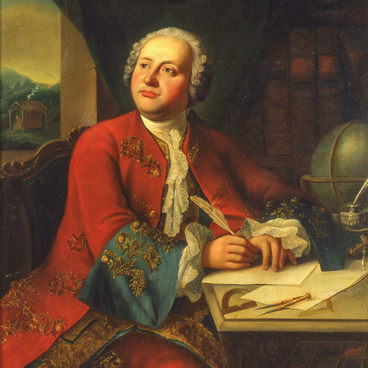The portrait of False Dmitry I is part of a series of five paintings: two portraits and three narrative paintings. All of them tell the story of the famous impostor and his wife Marina Mniszech. Previously, the artworks were housed in the Vyshnivets Palace, which was located near Ternopil in western Ukraine. In the middle of the 18th century, this estate belonged to the Polish Mniszech family, then in the 19th century, the owners changed, and the new proprietor sold the series of paintings to the heir of the Russian throne — Tsarevich Alexander Alexandrovich.
The narrative canvases from the series were painted by different masters, whereas the two paired portraits — of False Dmitry himself and his wife — were created by the same artist. These are old copies of the ceremonial images, which are located in the Wawel Castle in Krakow. Researchers suggest that originally both works were rectangular full-length portraits of the spouses, that were later given a rounded shape.
False Dmitry I, according to the most popular version, was a fugitive monk of the Moscow Chudov Monastery named Grigory (or Yury) Otrepyev. Around 1602, he fled Moscow and went to Kiev, which then was part of the Polish-Lithuanian Commonwealth. A year later, the future impostor went into the service of Prince Adam Wisniowiecki. Soon, according to one version, he fell ill or pretended to be so. A priest was called to him, and Otrepyev told him that in fact, he was Tsarevich Dmitry — the youngest son of Ivan the Terrible, who did not die in Uglich as a child, but survived and had been hiding in Poland for a long time. With the support of Adam Wisniowiecki, the impostor found several wealthy Polish patrons, including Voivode-Governor Jerzy (Yury) Mniszech, whose daughter False Dmitry soon married.
In the fall of 1604, he gathered a small army and went to capture Moscow. The sudden death of Tsar Boris Godunov and the death of his heir Fyodor Borisovich helped False Dmitry to seize the throne, and already in July 1605, he was crowned tsar. However, the new monarch did not govern for long: in May 1606, False Dmitry was killed as a result of a boyar coup d’état, led by Vasily Shuysky.
The narrative canvases from the series were painted by different masters, whereas the two paired portraits — of False Dmitry himself and his wife — were created by the same artist. These are old copies of the ceremonial images, which are located in the Wawel Castle in Krakow. Researchers suggest that originally both works were rectangular full-length portraits of the spouses, that were later given a rounded shape.
False Dmitry I, according to the most popular version, was a fugitive monk of the Moscow Chudov Monastery named Grigory (or Yury) Otrepyev. Around 1602, he fled Moscow and went to Kiev, which then was part of the Polish-Lithuanian Commonwealth. A year later, the future impostor went into the service of Prince Adam Wisniowiecki. Soon, according to one version, he fell ill or pretended to be so. A priest was called to him, and Otrepyev told him that in fact, he was Tsarevich Dmitry — the youngest son of Ivan the Terrible, who did not die in Uglich as a child, but survived and had been hiding in Poland for a long time. With the support of Adam Wisniowiecki, the impostor found several wealthy Polish patrons, including Voivode-Governor Jerzy (Yury) Mniszech, whose daughter False Dmitry soon married.
In the fall of 1604, he gathered a small army and went to capture Moscow. The sudden death of Tsar Boris Godunov and the death of his heir Fyodor Borisovich helped False Dmitry to seize the throne, and already in July 1605, he was crowned tsar. However, the new monarch did not govern for long: in May 1606, False Dmitry was killed as a result of a boyar coup d’état, led by Vasily Shuysky.



